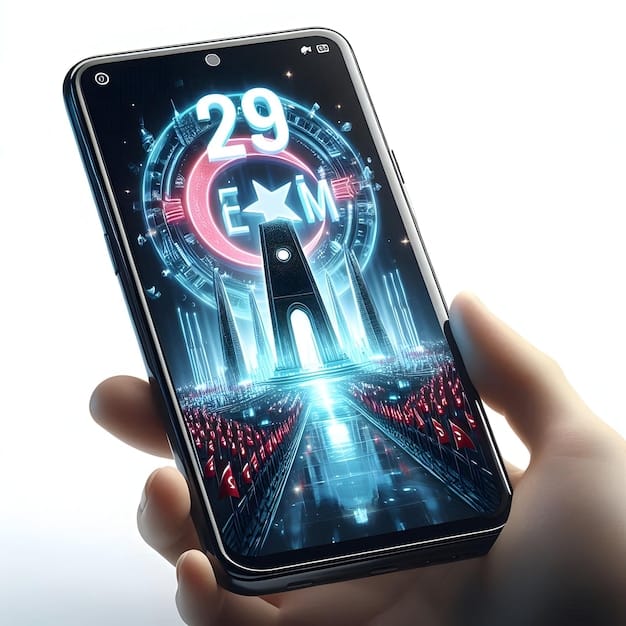The Impact of 5G on Mobile Gaming: A 2025 Forecast

The impact of 5G technology on mobile gaming in 2025 is expected to revolutionize the industry, bringing enhanced graphics, near-instantaneous response times, and immersive experiences to mobile gamers across the United States.
Get ready for a gaming revolution! By 2025, the impact of 5G technology on mobile gaming will be nothing short of transformative, offering unprecedented speed and responsiveness.
5G and Mobile Gaming: A Perfect Match
The convergence of 5G technology and mobile gaming is poised to redefine how we experience games on the go. With its promise of ultra-low latency and increased bandwidth, 5G offers the potential to overcome many of the limitations that have traditionally plagued mobile gaming.
What is 5G and Why Does it Matter for Gaming?
5G is the fifth generation of wireless technology, designed to provide faster speeds, lower latency, and greater capacity compared to its predecessors. For gaming, this translates to reduced lag, smoother gameplay, and the ability to stream high-resolution graphics without buffering.
Key Benefits of 5G for Mobile Gamers
For mobile gamers, 5G will unlock richer and more immersive gameplay experiences. It has the potential to greatly enhance the experiences in mobile gaming.
- Near-instantaneous response times
- Improved graphics and streaming quality
- Support for cloud gaming services
- Enhanced augmented reality (AR) and virtual reality (VR) experiences
The improvements that 5G brings to mobile gaming aren’t incremental, but can potentially revolutionize entire segments of the industry.

The Rise of Cloud Gaming on Mobile
One of the most significant impacts of 5G on mobile gaming will be the rise of cloud gaming. Cloud gaming allows players to stream games directly to their mobile devices, eliminating the need for expensive hardware or lengthy downloads.
How 5G Enables Cloud Gaming
5G’s high bandwidth and low latency make cloud gaming a viable option for mobile gamers. With a stable 5G connection, players can enjoy console-quality games on their smartphones and tablets without experiencing lag or performance issues.
Popular Cloud Gaming Services for Mobile
Several cloud gaming services are already available, offering a wide range of titles for mobile gamers. These include:
- Xbox Cloud Gaming
- NVIDIA GeForce Now
- Google Stadia
These services work by running the games on remote servers and streaming the video output to the player’s device, with the player’s input being sent back to the server in real time.
Augmented Reality (AR) and Virtual Reality (VR) Gaming
5G is also set to transform augmented reality (AR) and virtual reality (VR) gaming on mobile devices. AR games overlay digital content onto the real world, while VR games immerse players in entirely virtual environments.
The Potential of 5G for AR/VR Gaming
5G’s low latency and high bandwidth are crucial for delivering seamless and responsive AR/VR experiences. With 5G, mobile AR/VR games can offer more complex and detailed graphics, as well as improved tracking and interactivity.
Examples of AR/VR Games on Mobile
While AR/VR gaming on mobile is still in its early stages, there are already several exciting games and experiences available:
- Pokémon Go (AR)
- Ingress (AR)
- Google Cardboard (VR)
As 5G networks become more widespread, we can expect to see a surge in the development of innovative AR/VR games for mobile devices.
The Evolution of Mobile Esports
The rise of mobile esports is another area where 5G is expected to have a significant impact. Mobile esports involve competitive gaming on mobile devices, with players competing in popular titles like PUBG Mobile, Call of Duty: Mobile, and Mobile Legends: Bang Bang.
5G’s Role in Mobile Esports
5G’s low latency and high bandwidth are essential for competitive gaming, as they ensure that players have a fair and responsive playing field. With 5G, mobile esports tournaments can be held with minimal lag or connection issues, providing a better experience for both players and viewers.
The Growth of Mobile Esports
Mobile esports are experiencing rapid growth, particularly in regions with limited access to traditional gaming hardware. 5G is expected to further accelerate this growth by making mobile esports more accessible and enjoyable for players around the world.
It has been speculated that 5G and the accompanying technologies will increase the mobile esports market size to billions of dollars.

Challenges and Opportunities
While 5G holds immense potential for mobile gaming, there are also several challenges that need to be addressed. These include:
Infrastructure and Availability
One of the biggest challenges is the lack of widespread 5G infrastructure. Although 5G networks are being rolled out in major cities across the United States, it will take time before 5G coverage is available in all areas. This means that many mobile gamers may not be able to take advantage of 5G’s benefits for several years.
Cost and Affordability
Another challenge is the cost of 5G devices and data plans. 5G-enabled smartphones and tablets tend to be more expensive than their 4G counterparts, and 5G data plans can also be pricier. This could limit the adoption of 5G mobile gaming among budget-conscious consumers.
Technical Issues
Early adopters of 5G technology have encountered a myriad of teething problems. Some of the problems range from high battery usage, to cellular signal instability when a user moves between 4G and 5G zones.
Despite these challenges, the opportunities presented by 5G for mobile gaming are enormous. As 5G infrastructure expands and prices come down, more and more mobile gamers will be able to enjoy the benefits of this transformative technology.
Looking Ahead: Mobile Gaming in 2025
By 2025, 5G is expected to be widely available across the United States, transforming the mobile gaming landscape in profound ways. We can anticipate:
More Immersive and Engaging Games
5G will enable the development of more immersive and engaging mobile games with stunning graphics, realistic physics, and complex gameplay mechanics. Mobile gamers will be able to experience console-quality games on their smartphones and tablets, blurring the lines between mobile and console gaming.
New Genres and Experiences
5G will also pave the way for new genres and experiences in mobile gaming, such as massively multiplayer online games (MMOs), virtual reality (VR) simulations, and augmented reality (AR) adventures. These games will take full advantage of 5G’s low latency and high bandwidth to deliver unprecedented levels of interactivity and immersion.
The world of mobile gaming continues to evolve at a rapid rate and shows no sign of slowing down.
| Key Feature | Brief Description |
|---|---|
| 🚀 Speed & Latency | 5G offers faster speeds and lower latency for smoother gameplay. |
| 🎮 Cloud Gaming | Enables high-quality games on mobile devices without downloads. |
| ✨ AR/VR Gaming | Enhances augmented and virtual reality experiences on mobile. |
| 🏆 Mobile Esports | Supports competitive gaming with minimal lag and connection issues. |
Frequently Asked Questions
▼
5G reduces lag, improves graphics, and enables smoother gameplay, allowing for near-instantaneous response times and better streaming quality on mobile devices.
▼
Cloud gaming streams games to devices, eliminating the need for downloads. 5G’s high bandwidth and low latency make it possible to smoothly stream console-quality games.
▼
5G provides lower latency, enabling more complex and detailed graphics for AR and VR games, resulting in improved tracking, responsiveness, and more engaging experiences.
▼
5G ensures a fair and responsive playing field for competitive mobile gaming, minimizing lag and connection issues. It increases accessibility and enjoyment in mobile esports tournaments.
▼
Challenges include limited 5G infrastructure, the cost of 5G-enabled devices and data plans, and technical issues such as high battery usage and signal instability.
Conclusion
In conclusion, the impact of 5G technology on mobile gaming in 2025 is set to revolutionize the industry, bringing improved speed, low latency, and high bandwidth that will enhance gameplay and create new opportunities for developers and players alike. As 5G networks continue to expand and prices become more affordable, mobile gamers nationwide can anticipate an exciting future filled with immersive gaming experiences.





